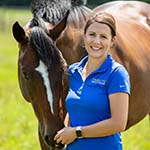Historically, many thought that the early pregnant mare could be fed like an open mare until the last 3-4 months of gestation. Research has shown that this practice may actually predispose the foal to Developmental Orthopedic Diseases (D.O.D.).
Trace nutrients, many of which are critical to normal bone development, are stored in the liver of the developing fetus. Mares not receiving adequate nutrition during gestation may not be able to shunt enough nutrients to support the developing foal during the last trimester - the most rapid growth phase.
Special attention must be given to the diet of the pregnant mare from conception to foaling, especially for essential amino acid balance and the levels of copper, zinc and possibly manganese. Current Nutrient Requirements of Horses (NRC, 2007) recommendations for copper and zinc are 100-125 mg and 400 mg/day, respectively. Some research suggests copper levels of 350 mg and zinc levels near 800-1,000 mg/day may reduce the incidence of D.O.D. The current NRC (2007) only addresses a single amino acid, lysine. The lysine requirements have been increased somewhat from previous publications without a correlating change to the overall protein requirement, suggesting increased attention to protein “quality” or amino acid balance instead of protein “quantity”.
Many pregnant mares are able to obtain enough calories from good quality forage to maintain or even gain weight. No forage, neither grass or legume hay or pasture, will supply all the nutrients needed by the broodmare for her own maintenance much less the trace minerals needed for sound fetal development. If the mare’s diet is deficient in specific nutrients, the fetus can pull many of the nutrients it needs from the dam’s body, up to a point. This is why we generally see a lower number of nutrition-related D.O.D.’s in a mare’s first or second foal. If the mare’s depleted body reserves are not replenished, deficiencies can occur in their future foals and eventually will affect the reproductive performance and health of the mare herself.
To keep the calories in a mare’s diet at a minimum so that she does not become obese but still assure adequate nutrition, concentrates have been formulated which contain three to five times the amount of critical amino acids, major minerals, trace minerals and vitamins found in most inexpensive horse feeds designed to be fed at higher rates. These feeds are often called ration balancers. They can supply the nutritional equivalent of six to ten pounds of typical horse feed without the extra calories. Well designed ration balancers will be based on the type of forage your horse is eating (i.e. grass, grass/legume mix, or legume).
Assessing the energy status of a mare is straightforward and can be easily accomplished through visual assessment of body condition score. Trace nutrient status is more difficult to assess and therefore is often overlooked; however, attention to supporting trace nutrient status throughout the entirety of gestation is key to provide a solid nutritional foundation for normal growth and development of foals.
Conclusion
A. Assess the TOTAL DIET (forage and concentrate combined) for proper balance. See Tribute Essential K and Growth for use with grass hay. See Alfa Essentials and Alfa Growth for hay greater than 50% legumes.
B. Have the mare at a body condition score of 5-6 coming in to foaling.
C. Nutrients most likely to be imbalanced or deficient:
- Essential amino acids
- Calcium to Phosphorous ratio (especially if using legumes)
- Copper and Zinc
D. Consult a qualified EQUINE nutritionist to help balance diets and adjust to problem situations.

